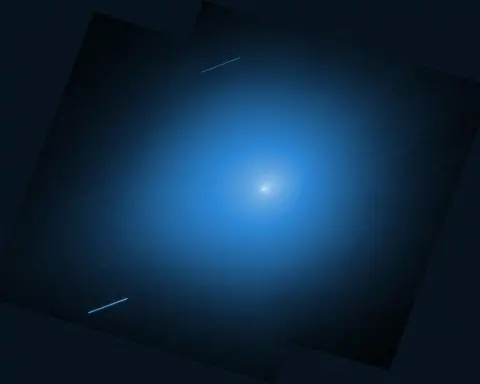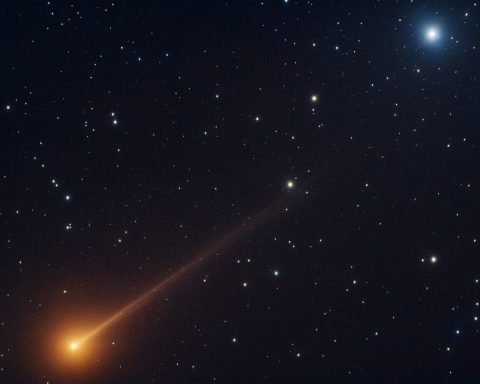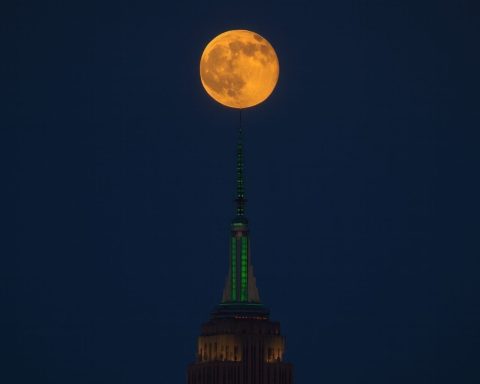- Draconid Meteor Shower Peaks: The annual Draconids reach maximum activity around October 8 with an expected rate of up to ~10 meteors per hour. A near-full supermoon this week will flood the sky with light, meaning only the brightest “shooting stars” or fireballs may be visible [1] [2]. The Draconids are notoriously unpredictable – sometimes nearly fizzling, but occasionally flaring with dramatic outbursts [3] – so skywatchers are encouraged to look up right after nightfall on Oct. 7–8 just in case [4].
- Aurora Alert (Geomagnetic Storm Watch): NOAA has issued a G1 (minor) geomagnetic storm watch for October 7–8, 2025, due to several coronal mass ejections aimed toward Earth [5]. While these solar eruptions are relatively slow and not expected to cause a severe storm, auroras could extend farther south than usual if G1 conditions materialize [6]. Northern lights might glow on the horizon in parts of the northern U.S. (as far south as states like Idaho, Michigan and New York) and northern Europe (Scotland, Scandinavia) under clear, dark skies [7]. Skywatchers should monitor local aurora forecasts and look north after nightfall on Oct. 7–8.
- Harvest Supermoon & Bright Moonlight: A brilliant Harvest Moon – which was also the last supermoon of the year – lit up the sky on October 6, appearing about 14% bigger and 30% brighter than an average full moon [8]. Now a few days past full, this waning gibbous moon remains exceptionally bright on Oct. 7–8, washing out faint stars and meteors [9]. There are no eclipses on these dates (the full Moon was not eclipsed), so its glare is uninterrupted. The moon’s intense light is the main obstacle for meteor-spotting this week [10], but it also creates a beautiful spectacle of its own – a golden orb illuminating the autumn night.
- Planets on Display:Saturn stands out in the evening skies of early October, currently situated in the constellation Aquarius and visible as a steady, golden “star” in the southeast after dusk [11]. In fact, on Oct. 5 the nearly full Moon passed right by Saturn, helping point the way to the ringed planet [12]. By Oct. 7–8 the Moon has moved on, but Saturn is still well placed for viewing throughout the first half of the night. With even a small telescope you can glimpse Saturn’s famous rings (now tilted edge-on and appearing as a thin line this year). Jupiter is also coming into prime time – the gas giant rises by around midnight and blazes bright in the late-night and pre-dawn eastern sky [13]. Jupiter outshines all the stars, so it’s easy to spot once it’s up. Meanwhile Venus continues to dazzle as the “Morning Star,” visible low in the east before sunrise [14]. Mercury and Mars are the trickiest planets at the moment – both are buried in the glow of twilight (very low on the horizon after sunset) and not readily visible to the naked eye [15] [16]. Aside from the Moon-Saturn pairing on Oct. 5, there aren’t major planetary conjunctions on Oct. 7–8, but skywatchers can enjoy Saturn in the evening, Jupiter late at night, and Venus at dawn, all aligned along the ecliptic path of the Sun.
- New Comets Gracing the Twilight: Two newly-discovered comets are making an appearance in early October’s skies, offering a treat for those with binoculars or a small telescope. Comet C/2025 A6 (Lemmon) is drawing attention as it brightens on its approach – it was around magnitude +7 in early October and could become naked-eye visible later in the month if it continues to brighten [17]. Discovered in January 2025 at the Mt. Lemmon Observatory, this comet will make its closest pass by Earth on Oct. 21 [18]. Right now (Oct. 7–8), Comet Lemmon can be found in the northern sky after sunset, visible as a faint fuzzy patch of light with optical aid [19]. It has developed an attractive tail and a greenish coma in photographs [20], hinting at what might become the year’s best comet if predictions hold. Comet C/2025 R2 (SWAN) is another icy visitor now emerging in the west after sundown [21]. Comet SWAN was detected only recently (by the SOHO spacecraft’s SWAN instrument) and is also expected to brighten through October. While still too dim to see without assistance, both comets Lemmon and SWAN can be observed with binoculars under dark skies this week [22]. If you know where to look (and have a star chart or astronomy app), try scanning the northwestern skies shortly after evening twilight for any small hazy “star” – that just might be a comet. With a little luck and clear skies, Comet Lemmon in particular may soon reach the threshold of naked-eye visibility around late October [23], making it a potential highlight for skywatchers in the coming weeks.
Draconid Meteor Shower Peaks in Early Evening
The Draconid meteor shower – a minor but convenient annual shower – is active October 6–10 and is expected to peak on the night of October 8, 2025 [24]. The Draconids are so named because their meteors appear to fan out from the head of the constellation Draco, the Dragon, which lies in the northwestern sky after nightfall in October [25] [26]. Unlike many meteor showers that are best in the wee hours of morning, the Draconids are most easily viewed in the early evening – just after darkness falls – because Draco’s radiant point is highest in the sky at nightfall for mid-northern latitudes [27]. This makes the Draconids a favorite for those who don’t want to stay up all night hunting meteors.
In most years, the Draconids are a relatively mild shower, typically producing at most 5–10 meteors per hour under ideal conditions [28]. This year’s forecast is in that modest range – around ten meteors per hour at the peak. However, 2025 is not an ideal year for meteor visibility: the Moon is nearly full during the shower’s peak, and its bright light will wash out the fainter meteors [29]. In fact, a supermoon occurred on Oct. 6 (just two nights before the peak), so the Moon on Oct. 7–8 remains a large, glaring presence in the sky. Under such moonlight, observers might only see the very brightest Draconid meteors, sometimes known as “fireballs” when they leave glowing trails [30] [31]. “If you don’t see any, you can always blame the bright supermoon,” NASA quipped in its monthly skywatching bulletin [32]. Essentially, the lunar glare will likely drown out the delicate drizzle of Draconid meteors for most casual viewers.
That said, the Draconids are notoriously unpredictable. The American Meteor Society (AMS) notes that this shower has produced rare outbursts in the past (for example, spectacular storms in 1933 and 1946, and more recently a flurry of activity in 2011) [33]. Most years it barely sputters, but “on rare occasions, [it can] flare dramatically” with hundreds of meteors if Earth passes through a dense clump of debris [34]. The meteors originate from debris left by Comet 21P/Giacobini–Zinner, and as Earth plows through the comet’s dust trail, we see those bits of comet burn up as shooting stars [35]. This year, no major outburst is predicted – but with meteor showers, surprises are always possible.
How to watch the Draconids: Find a dark location away from city lights, and give your eyes time to adjust (at least 20 minutes). Since the Moon will be extremely bright, try to position yourself so that something (a building, a hill, or trees) blocks the Moon from your direct view [36]. Face generally toward the north or northwest, and scan the sky for meteors appearing to streak away from the Draco region. Peak activity is expected on the evening of Oct. 8, but you might see a few meteors on the 7th and even on the nights surrounding the peak. Don’t expect a torrent of shooting stars – think of it as a leisurely dragon’s breath, with the chance that one or two brilliant fireballs might blaze through the sky early in the night [37]. If clouds or moonlight ruin the show, take heart that later in October the Orionid meteor shower (peaking on Oct. 21) will bring another opportunity, with higher rates – around 20 meteors per hour – under darker skies [38] (the Moon will be a thin crescent during Orionid peak). In short, catching a Draconid meteor this week will be a matter of patience and luck, but even one bright meteor blazing past Draco’s stars can make the effort worthwhile.
Aurora Alert: Minor Geomagnetic Storm Could Bring Northern Lights South
Skywatchers have another reason to look up on Oct. 7–8: a potential aurora display. The NOAA Space Weather Prediction Center has issued a G1 (Minor) Geomagnetic Storm Watch for those dates [39]. This alert comes after scientists observed multiple coronal mass ejections (CMEs) – eruptions of magnetized plasma from the Sun – that are headed in Earth’s direction [40]. These particular CMEs are relatively slow-moving and not expected to trigger a major geomagnetic tempest; however, even a minor G1-class storm can energize Earth’s northern (and southern) lights and make them visible in places they normally aren’t [41].
According to timeanddate.com (which summarized the official NOAA forecast), the G1 watch is in effect for October 7–8 as the CME particles are due to arrive around that time [42]. G1 storms correspond to a Kp index of 5 (on a 0–9 scale of geomagnetic activity), which means auroras could dip to relatively lower latitudes than usual. If the forecast holds, Aurora Borealis may be glimpsed not only across the high-latitude regions (Canada, Alaska, Scandinavia) but also further south. In North America, areas as far south as the northern United States (e.g. Idaho, North Dakota, Wisconsin, Michigan, New York, Maine) might catch a faint auroral glow on the northern horizon [43]. In Europe, auroras could appear over Scotland and the northern UK, and of course across Norway, Sweden, Finland, etc. [44]. In the southern hemisphere, this minor storm could spark Aurora Australis visible from the southern parts of New Zealand, Tasmania, or southern Argentina/Chile [45].
Do keep in mind that geomagnetic storm predictions are an inexact science – the timing and intensity of auroras can change with little notice. The CMEs heading our way are not particularly fast or potent, so forecasters note they are less likely to produce intense geomagnetic storms, but minor storm conditions remain possible [46]. It’s a bit of a cosmic lottery: we might get a beautiful auroral display, or we might just get a quiet night. Solar activity is high in general this year, since the Sun is nearing its peak of the 11-year cycle (the solar maximum), meaning lots of sunspots and frequent solar flares and CMEs are occurring [47]. That bodes well for aurora enthusiasts: more solar storms mean more chances for northern lights. Additionally, early autumn is historically a good time for auroras because around the equinox (Sept. 22), the alignment of Earth’s magnetic field with the solar wind tends to enhance geomagnetic activity [48] [49]. This is known as the equinox effect, which can make auroras “twice as likely” in early October compared to midsummer [50].
Tips to see the aurora: To maximize your chances, find a dark location with an unobstructed view of the northern horizon (or southern horizon if you’re in the far Southern Hemisphere) [51]. Check the weather and choose a time when skies are clear of clouds – auroras won’t be visible through heavy cloud cover [52]. The darkest hours of the night (generally midnight to 3 AM local time) are usually best, though auroras from a G1 storm, if they appear at lower latitudes, may just hover low above the horizon. If you’re in a city or suburb, try to get away from streetlights and urban light pollution [53]. Let your eyes adjust to the darkness and look north. Auroras might appear as a faint greenish or whitish glow at first, like light pollution or a low cloud – but unlike a cloud, the glow will tend to brighten, move or pulse, and possibly show faint pillars or curtains of light. Be patient: auroral activity can ebb and flow. You can also keep an eye on real-time aurora alerts from resources like NOAA’s 30-minute aurora forecast maps or the Space Weather Live website [54], which track the geomagnetic conditions. If the Kp index (a global geomagnetic activity measure) is sustained at 5 or above, your chances of seeing auroras at mid-northern latitudes improve. And if you do spot the northern lights, even faintly, it’s a memorable experience – the sky may shimmer in green, and long-exposure photos might reveal pink or purple fringes that your eyes can’t easily see.
In summary, a minor geomagnetic storm watch means there’s a decent chance the Earth’s magnetic field will be rattled just enough to ignite auroras on Oct. 7 or 8. It’s by no means a guarantee for everyone, but the prospect of seeing the Northern Lights dancing farther south than usual has many skywatchers excited [55] [56]. Keep your fingers crossed for clear, dark skies, and you just might catch a glimpse of the aurora’s ghostly glow – a reminder of our star’s dynamic connection with Earth.
Moon and Planetary Alignments in Early October
While we focus on meteors and auroras, let’s not forget the planetary showcase and our beaming Moon this week. October 7–8 features a waning gibbous Moon (just a couple days past full) that rises early in the evening and shines brightly most of the night. This recent full Moon was special – it was the “Harvest Moon” (the full moon closest to the September equinox) and also a supermoon. At perigee (closest point in its orbit), the Moon appeared larger and brighter than usual – about 14% bigger in diameter and 30% brighter in area compared to a micromoon at apogee [57]. Many skywatchers noticed the brilliance of this supermoon on Oct. 6–7. Now on the 7th and 8th, the Moon is a tad less full but still very bright. Its glow will be the dominant light in the night sky, outshining most stars. (For context, this is the fourth and final supermoon of 2025, capping a series of especially big full Moons [58].)
Importantly, there are no lunar eclipses or solar eclipses happening on October 7–8, 2025. The full Moon earlier this week was not eclipsed – Earth’s shadow missed the Moon this time. So we won’t see any “blood moon” or darkening; the Moon will stay bright and fully illuminated throughout the night. The next eclipse in 2025 is a total lunar eclipse on September 7, 2025 (nearly a year from now) [59], so nothing to mark on your calendar for this particular week in terms of eclipse chasing.
Turning to the planets: October evenings currently feature a prominent Saturn and later at night Jupiter, with Venus gracing the pre-dawn sky. Saturn is the star of the evening sky this month. After sunset, Saturn is already visible in the southeast, glowing with a steady yellowish light (distinguishing it from twinkling stars). It is located in Aquarius (near the Capricornus-Aquarius border) and reaches its highest point in the south a few hours after dark. Around October 5, observers enjoyed a lovely pairing of the Moon and Saturn – the nearly full Moon was right next to Saturn in the sky, making it easy to find the ringed planet [60]. If you saw the bright Moon that night, that slightly fainter “star” nearby was Saturn. By Oct. 7–8, the Moon has moved roughly 20–30 degrees away, but you can still identify Saturn on its own. It’s about as bright as a first-magnitude star and doesn’t twinkle much. Through binoculars or a small telescope, Saturn is a treat – you can see the rings! In late 2025 the rings are nearly edge-on from our viewpoint (they appear as a thin line of light on either side of Saturn’s sphere, since Saturn’s tilt relative to Earth has its ring plane nearly edge-on [61]). Even so, knowing you’re seeing Saturn’s rings is thrilling for new observers. Also, with a telescope you might spot Titan, Saturn’s largest moon, as a tiny speck nearby.
Moving later into the night, Jupiter takes over as the brightest object in the post-moonrise sky (aside from the Moon itself). Jupiter is currently rising around midnight local time (a bit earlier for more eastern longitudes, later for western) and by the very early morning hours it climbs high in the east [62]. Jupiter is brilliant white and impossible to miss once it’s above the horizon – it outshines even Sirius, the brightest star. If you’re up at 5–6 AM, you’ll see Jupiter high in the southwest (having risen around midnight) and Venus low in the east, a beautiful two-planet morning display. Through a telescope, Jupiter’s cloud bands and its four large moons (Io, Europa, Ganymede, Callisto) are visible. In fact, Jupiter is nearing opposition (coming in late January 2026, since there was no opposition in calendar 2025), so it’s growing brighter and more observable each week. During Oct. 7–8, Jupiter sits against the stars of Aries (moving towards Taurus), and interestingly, it’s not far from where the Moon was during the full moon – but by the time Jupiter rises, the Moon will have shifted further west in the sky.
The pre-dawn hours also showcase Venus, which currently shines as the “Morning Star.” Venus spent much of mid-2025 hidden near the Sun, but it emerged as a morning object in recent weeks. Now it rises a few hours before sunrise and gleams extremely brightly (magnitude –4) low in the east at dawn [63]. If you are out before the Sun comes up (around 5–6 AM local time), look east to spot Venus – you might mistake it for an airplane or a distant flashlight because it’s so intensely bright. It’s often visible even in twilight. Venus in early October is moving through the constellation Leo, not far from where the Sun will rise. Over the coming months, Venus will remain a glorious morning beacon.
Two other planets, Mars and Mercury, are technically around but not easily visible during Oct. 7–8. Mars has faded considerably since its last opposition (which was in late 2022); by now in 2025 it’s a rather dim, distant object. It’s also currently lingering very low in the west after sunset and essentially lost in twilight’s glow [64]. Mars is only magnitude ~1.7 now – not bright enough to pierce the bright sky near the horizon. Additionally, Mars is heading toward a solar conjunction (it will soon be behind the Sun from Earth’s perspective), so we won’t see Mars well again until it emerges in the morning sky next year. Mercury, the innermost planet, was at greatest elongation in mid-September and is now also a very tough catch. By early October Mercury has just about disappeared into the Sun’s glare, setting shortly after the Sun. It will reappear later in October in the morning sky for a brief time. So for this week, Mercury and Mars are effectively out of view for casual skywatchers [65] [66].
In summary, the planetary line-up on Oct. 7–8 goes like this: after sunset, Saturn is the lone bright planet of the evening (look southeast); the Moon is also in the evening sky, shining bright and moving through Aries/Taurus; around midnight Jupiter rises in the east, joining the Moon; by dawn, Venus is rising in the east while Jupiter sets toward the west. All these planets roughly trace the ecliptic – the Sun’s path – across the sky. There isn’t a special “alignment” or conjunction among them on these specific nights, but it’s still a lovely progression of planets through the night. If you have clear skies, take a moment to enjoy Saturn in the early night, and if you’re up early, catch brilliant Venus heralding the sunrise. The Moon, of course, will muscle its way into almost all these scenes with its overpowering light – but that’s part of the experience of this week’s sky. As the saying goes, the Moon and planets will “steal the show” from the fainter stars.
Two New Comets: Lemmon & SWAN Dazzle Binocular Observers
Comet lovers have something to be excited about this month. Two newly discovered comets are currently visible (with optical aid) and are on track to potentially become naked-eye objects later in October. During the nights of Oct. 7–8, you might try your luck spotting Comet C/2025 A6 (Lemmon) and Comet C/2025 R2 (SWAN), which are both trekking through our twilight skies.
Comet C/2025 A6 (Lemmon) is shaping up to be one of the year’s most interesting comets. Discovered on January 3, 2025, by the Mount Lemmon Observatory in Arizona, this comet has been steadily brightening as it approaches the inner solar system [67]. By early October it reached around magnitude +7 (just below the threshold of naked-eye visibility), and it’s projected to brighten further in the coming weeks [68]. Astronomers predict Comet Lemmon might become faintly visible to the unaided eye by mid or late October if it continues this trend [69]. Its closest approach to Earth will occur on Oct. 21, 2025, at a distance of about 55 million miles [70], and it reaches perihelion (closest to the Sun) on Nov. 8. During Oct. 7–8, Comet Lemmon is located in the northern sky after sunset – roughly in the direction of the constellation Ursa Major (the Big Dipper) early in the month, though quite low on the horizon at dusk [71] [72]. Observers in the Northern Hemisphere have the advantage, as the comet stays north. Initially, Comet Lemmon was easier to catch in the early morning sky before dawn (when it was higher up) [73], but each day it’s moving a bit more into the evening sky. By mid-October it will be easier to see in the early evenings as it climbs higher after sunset [74]. Right now, if you want to try spotting it around Oct. 7–8, bring binoculars and find a viewing spot with a clear view toward the northwest horizon after the Sun has set. The comet will appear as a small fuzzy patch of light. It won’t have a long tail to the naked eye (those spectacular tails show up mainly in photos), but you might perceive a faint smudge, especially if using binoculars or a telescope. Long-exposure photographs taken in late September show Comet Lemmon’s gorgeous tail – a bluish streamer of ionized gas – and a bright green coma (glowing from carbon gas) [75]. These images have many calling Comet Lemmon potentially the “best comet of 2025.” Of course, comets are notoriously unpredictable – they can fizzle out or disintegrate without warning. But optimists are hoping this one could reach magnitude 5 or even 4 (making it visible under dark skies) later this month [76]. If that happens, you might be able to spot Comet Lemmon with your unaided eyes from a dark rural location by the end of October. Even if it remains just below naked-eye level, it will be an easy binocular target and a fine object for amateur astrophotography. Mark your calendar for the last week of October, when Comet Lemmon is forecast to be at its brightest [77] – but in the meantime, attempting a glimpse on Oct. 7–8 is a fun challenge for dedicated comet hunters.
The second comet, Comet C/2025 R2 (SWAN), is a more recent discovery and has an interesting story. It was first spotted in September 2025 via the SOHO satellite’s SWAN instrument (which detects hydrogen in comets). Comet SWAN is now making its debut in Earth’s night sky. As of early October, it is also around binocular visibility (reports suggest it’s in the magnitude 7–8 range). Comet SWAN’s orbit suggests it will pass relatively close to Earth (though not as close as Lemmon) and could also brighten to near naked-eye levels around mid to late October [78]. During Oct. 7–8, SWAN is said to be visible just after sunset in the west [79]. It’s likely positioned a bit south of where Comet Lemmon is, perhaps in or near the constellation Virgo or Libra (this will change as it moves). The key is that both Comet Lemmon and Comet SWAN are evening objects in early October – which is great news, because you can try to see them at a convenient time, not just at 3 AM! The flip side is that they are competing with twilight and that big Moon, so they won’t be obvious.
To observe these comets, follow these general tips: Use binoculars or a telescope, because they are too faint to spot with eyes alone right now [80]. Go to a location with dark skies and a clear view of the horizon (especially the northwest and west horizons after sunset). Check comet finder charts from credible astronomy websites or apps – comets move day to day, so you’ll want the current position. For Comet Lemmon, some sources note it spending early October near the constellation Canes Venatici, not far from the handle of the Big Dipper (though very low in the sky at dusk) [81]. Comet SWAN’s position is a bit different; as a newer comet, you might need updated coordinates (some astronomy news outlets or services like TheSkyLive can provide real-time positions). After the Sun sets and the sky begins to darken, start scanning the target area with binoculars. A comet will look like a diffuse round glow, not a pinpoint. If you have a small telescope, at low power the comet’s tail might just barely be detectable as an elongation of the glow. Patience is key – try again on multiple nights, as each night the comets will be in slightly different spots and potentially a tad brighter.
These comets are particularly exciting because we haven’t had a bright comet in a little while. Early indications are that Comet Lemmon could reach magnitude 4 or even brighter near the end of the month, which would make it the brightest comet of 2025 visible in Earth’s skies [82]. Comet SWAN’s potential is a bit more uncertain, but it’s certainly one to watch as well (it’s not uncommon for SOHO-discovered comets to surprise us). By Oct. 20–23, some predictions say Comet SWAN might also hover around the naked-eye limit [83]. We will have to wait and see.
For now, Oct. 7–8 offers a preview of these icy visitors. Even if you don’t manage to spot them now, simply knowing two comets are out there – one with a striking green coma and one freshly plucked from the Sun’s domain – adds a sense of wonder to the night. You might be gazing in the right direction and not realize a tiny comet is quietly tracing through the stars. As always with comets, expect the unexpected, and keep those binoculars handy for later in October when viewing conditions for Comet Lemmon and Comet SWAN should improve.
Sources: The information in this roundup is drawn from NASA’s skywatching guide [84] [85], official NOAA space weather alerts [86], the American Meteor Society and astronomy news outlets like EarthSky, Space.com, Live Science and TimeandDate. These expert sources provide the latest forecasts and tips for amateur astronomers. For further details, check out NASA’s What’s Up skywatching article [87] [88], the NOAA Space Weather Prediction Center for aurora alerts [89], and observatory sites like the International Meteor Organization and American Meteor Society for meteor shower updates. Happy skywatching, and clear skies to all! [90] [91]
References
1. science.nasa.gov, 2. www.livescience.com, 3. www.livescience.com, 4. www.livescience.com, 5. www.timeanddate.com, 6. www.timeanddate.com, 7. www.timeanddate.com, 8. science.nasa.gov, 9. earthsky.org, 10. science.nasa.gov, 11. earthsky.org, 12. www.space.com, 13. earthsky.org, 14. earthsky.org, 15. earthsky.org, 16. earthsky.org, 17. www.space.com, 18. www.space.com, 19. www.livescience.com, 20. www.space.com, 21. www.livescience.com, 22. www.livescience.com, 23. www.space.com, 24. www.livescience.com, 25. science.nasa.gov, 26. www.livescience.com, 27. www.livescience.com, 28. science.nasa.gov, 29. earthsky.org, 30. www.livescience.com, 31. www.livescience.com, 32. science.nasa.gov, 33. www.livescience.com, 34. www.livescience.com, 35. science.nasa.gov, 36. earthsky.org, 37. www.livescience.com, 38. science.nasa.gov, 39. www.timeanddate.com, 40. www.timeanddate.com, 41. www.timeanddate.com, 42. www.timeanddate.com, 43. www.timeanddate.com, 44. www.timeanddate.com, 45. www.timeanddate.com, 46. www.timeanddate.com, 47. www.timeanddate.com, 48. www.timeanddate.com, 49. www.livescience.com, 50. www.livescience.com, 51. www.timeanddate.com, 52. www.timeanddate.com, 53. www.timeanddate.com, 54. www.livescience.com, 55. www.timeanddate.com, 56. www.timeanddate.com, 57. science.nasa.gov, 58. earthsky.org, 59. www.farmersalmanac.com, 60. www.space.com, 61. earthsky.org, 62. earthsky.org, 63. earthsky.org, 64. earthsky.org, 65. earthsky.org, 66. earthsky.org, 67. www.space.com, 68. www.space.com, 69. www.space.com, 70. www.space.com, 71. www.livescience.com, 72. earthsky.org, 73. earthsky.org, 74. earthsky.org, 75. www.space.com, 76. earthsky.org, 77. earthsky.org, 78. www.facebook.com, 79. www.livescience.com, 80. www.livescience.com, 81. earthsky.org, 82. earthsky.org, 83. www.facebook.com, 84. science.nasa.gov, 85. science.nasa.gov, 86. www.timeanddate.com, 87. science.nasa.gov, 88. science.nasa.gov, 89. www.timeanddate.com, 90. www.timeanddate.com, 91. www.livescience.com










